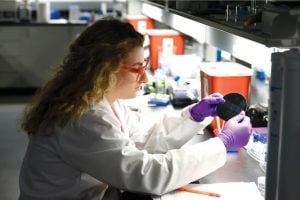
This article was written by Poornima Apte and seen in The JHU Engineering Magazine, Winter 2025 edition.
When Jocelyn Freed last visited the National Air and Space Museum in Washington, D.C., the fourth-year materials science and engineering major was drawn to a video showcasing Amy Ross, an engineer who designs space suits for NASA. It would turn out to be a defining moment for Freed. Soon after, she decided she would pursue a materials engineering career related to aerospace.
“Up until then, I didn’t think that a job so specific like making spacesuits could be available to me,” Freed says. “After that, I got interested in not just spacesuits, but also coatings and all things aerospace.”
Last summer, she landed an internship at the aerospace startup Ursa Major, funded by the Brooke Owens Fellowship, which encourages women’s participation in the field. There, she tested the hardness, tensile, and fatigue strength of nickel “superalloys” strengthened with elements like cobalt or carbon. (Nickel alloys are ideal for aerospace applications because of their high strength to weight and resistance to extreme temperatures.) The tests involved evaluating the forces at which the alloys fracture or break apart. Freed also studied the structure of the alloys using optical and scanning electron microscopy, and jumped in to write a simpler manual for the startup’s optical microscope, complete with illustrations, after noting the group’s existing manual was long and difficult to understand.
This academic year, Freed gets to work on space suits as part of her senior design project. In the lab of Michael Bevan, a professor of chemical and biomolecular engineering, she is evaluating the effects of electrical fields on microscopic colloidal particles, which are tiny particles suspended in fluid. A space suit coated with such materials would more effectively repel “space junk,” materials that can pierce the suit, causing air to leak out.
Freed says she especially loves the intersection of materials science and aerospace because it opens so many opportunities and topics to explore. “The field of aerospace materials sounds so specific, but at the same time, it’s so broad; you can work on metals, on polymers, on ceramics. It’s a lot of fun,” she says.
No matter what she pursues after her undergraduate studies, Freed knows there will be room for art, which she is pursuing through a minor at JHU. “I’ve always been a creative person,” she says. “Art exercises a different part of my brain.”